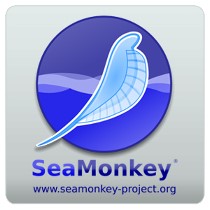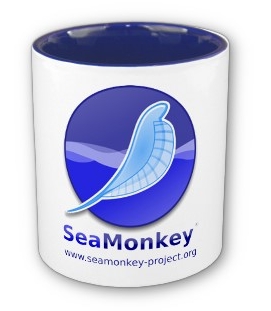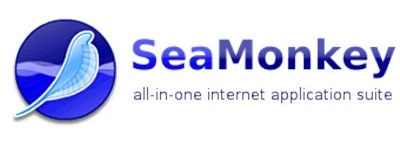*Seamonkey* web browser
INSTALL & Usage NOTES
circa 2010-2012
(versions 1.1.17, 2.0.11, 2.2, 2.10.1)
by 'Blaze'

*Seamonkey* web browser
INSTALL & Usage NOTES
by 'Blaze' |

|
! Note !
More notes may be added,
if/when I re-visit this page.
SECTIONS BELOW:
Introduction
Original Install
(on Ubuntu 9.10, 32-bit, version 1.1.17)
Upgrade from 1.x to 2.0
(on Ubuntu 9.10, 32-bit, version 2.0.11)
Attempt from 2.0 to 2.2
(on Ubuntu 9.10, 32-bit, version 2.2)
Upgrade to 2.10
(on Ubuntu 9.10, 32-bit, version 2.10)
32-bit Install Attempt
(on LMDE = Linux Mint Debian Edition, 64-bit, 2.x versions)
64bit Install
(on LMDE = Linux Mint Debian Edition, version 2.10.1)
Setting Helper Apps
(in 2010-2012 versions)
Tailor Preferences
(via 'Edit > Preferences')
More Info
(via 'external' web sites)
BottomOfPage
|
Introduction : This page is meant as a collection place for notes on installing and using the Seamonkey web browser circa 2010-2012, on Ubuntu 9.10 (and on LMDE = Linux Mint Debian Edition) --- various versions of Seamonkey (Wikipedia link). For some general information on Seamonkey, see the MENU-of-Seamonkey-Notes page --- a 'parent' page that serves to provide a link to this page --- as well as links to pages of Notes on installing or upgrading Seamonkey in more recent years and decades. The general info on that page includes some discussion on why Seamonkey is an appealing web browser --- and includes many links to 'external' web sites with more information on Seamonkey. Navigation of this page : To help find the notes on various topics, the Section-links near the top of this page provide a way to jump down to sections of this page. But that will not always be the best way to find information on this page, so ...
Note: |
|
Original Install of Seamonkey When I originally installed Seamonkey (in Ubuntu 9.10 2009.October Linux), I went to the Seamonkey web site and downloaded the Linux version (version 1.1.17) into a 'seamonkey' directory of an 'apps' subdirectory of my home directory --- $HOME/apps/seamonkey. I installed it there, circa 2010 Feb. The Seamonkey install files for Linux distros are compressed 'tar.bz2' archive files that contain the main executable along with directories of '.so' 'shared object' files --- as well as various image and text files. I un-compressed and un-tarred the install file into the $HOME/apps/seamonkey --- using the 'Archive Manager' (File Roller 2.28.1) in the Nautilus file manager (Nautilus 2.28.1) of the Gnome2 desktop environment that was used in Ubuntu 9.10. I set up desktop icons and 'top panel' icons using the 'Create Launcher' utilities of the Nautilus file manager of the Gnome2 desktop environment. I proceeded to use Seamonkey 1.1.17 for several months. See the next section. |
|
Upgrade from Seamonkey 1.x to 2.0 Around 2011 Jan, I noticed that a newer Seamonkey version (2.0.11) was available via the Ubuntu Software Center GUI interface that is the handy way to install some of the most popular software apps in Ubuntu. I used the 'Software Center' to install version 2.0.11. This install put the main files in /usr directories. The executable was
The directory '/usr/lib/seamonkey-2.0.11' included the following directories and files: |
chrome/
components/
defaults/
dictionaries@
extensions/
greprefs/
isp/
modules/
plugins/
res/
searchplugins/
README
application.ini
libgfxpsshar.so
libgkgfx.so
libgtkxtbin.so
libjsj.so
libldap60.so
libldif60.so
libmozjs.so
libnssckbi.so@
libprldap60.so
libsqlite3.so
libssldap60.so
libthebes.so
libxpcom.so
libxpcom_core.so
libxul.so
mozilla-xremote-client*
platform.ini
removed-files
run-mozilla.sh*
seamonkey-2.0*
seamonkey-2.0-bin*
|
The trailing @ sign indicates links and the trailing * sign indicates executables. I proceeded to use Seamonkey 2.0.11. |
|
Attempt To Upgrade to from Seamonkey 2.0 to 2.2 After the 2.0.11 version there were no new versions of SeaMonkey available via the Ubuntu 9.10 Software Center. Around July 2011, I tried installing the 2.2 version from the Seamonkey website. I downloaded the tar.bz2 file into a 'seamonkey2-2' subdirectory of the 'apps' directory of my home directory and 'expanded' the file using the 'Archive Manager' (File Roller 2.28.1) in the Nautilus file manager (Nautilus 2.28.1). But when I tried starting up the new 2.2 version of Seamonkey via the 'seamonkey' startup script in my $HOME/apps/seamonkey2-2 installation directory, the previous version of Seamonkey started up. I did a little investigating of the 'seamonkey' startup script, and it uses some spaghetti-like logic to determine which Seamonkey files to use. I did not want to spend a lot of time on getting the 2.2 version going (and perhaps fudge up the 2.0.11 installation), so I kept using the version installed via the Ubuntu Software Center. |
|
Upgrade to Seamonkey 2.10 In 2012 June, I noticed that a new 2.10 release of Seamonkey was available, and, since Seamonkey was implementing more and more of the HTML 5 standard, I thought it was about time to try to install a newer version of Seamonkey on my (old) Ubuntu 9.10 workhorse. Like I did with the 2.2 download, I made a subdirectory of my $HOME/apps directory --- called it seamonkey2-10 --- and downloaded the tar.bz2 file there. Then I dearchived it and tried starting the 'seamonkey' startup script. As expected, it started the old version of Seamonkey. BUT ... This time I decided to try renaming the old seamonkey executable (link) and the old seamonkey 'lib' directory out of the way. So I renamed
/usr/bin/seamonkey and I renamed the 'lib' directory
/usr/lib/seamonkey-2.0.11 I started the 'seamonkey' startup script in my $HOME/apps/seamonkey2-10/seamonkey directory. In the Seamonkey window that appeared, the 'About Seamonkey' option, in the drop-down menu from the 'Help' option of the top toolbar, showed that 2.10 was indeed running. I had a desktop icon and an upper Gnome panel icon for Seamonkey. They no longer worked because they pointed to the old executable. I right-clicked on each of those icons and used the 'Properties' option to change the path to the startup script so that it was $HOME/apps/seamonkey2-10/seamonkey/seamonkey where $HOME represents my home directory. So that concluded the installation. Well, I thought it did. But I also have an installation of the Thunderbird email client. And that had been configured to use a previous verion of SeaMonkey when I clicked on a web link in an email. You can see how I set up the new version of SeaMonkey to be used by Thunderbird --- in a Thunderbird Configuration and Usage Notes page. By the way, after installing the SeaMonkey files in my 'home-apps' directory, the files were owned by my userid rather than 'root'. I noticed on the web that some people voiced some concern about installing apps under a userid account rather than 'root'. To provide an added measure of protection, I took the 'write' permissions off of the files in the SeaMonkey 2.10 installation. This amounted to changing '-rwxr-xr-x' (755) permissions to '-r-xr-xr-x' (555) and changing '-rw-r--r--' (644) permissions to '-r--r--r--' (444). I should point out that the first time I started up the 2.10 version, it presented me with some screens that indicated the first invocation of the new version was giving me the option to keep some previously installed plug-ins (Chatzilla, DOM Inspector, and JavaScript Debugger) --- or re-configure. If I find that I have to make any more changes to complete the installation (such as redefine some 'Helper Applications' via the 'Edit > Preferences > Browser > Helper Applications' menu path), I may add those notes to this page. Note that since the architecture of other Mozilla products such as Firefox (web browser) and Thunderbird (email client) are similar to that of SeaMonkey, they probably can also be installed in a home directory rather than scattered throughout various sub-directories of /usr. And this may also apply to other Mozilla systems such as the scheduling and calendaring apps, Sunbird and Lightning --- if these apps provide all the necessary '.so' (shared object) files in the user's Seamonkey installation directory. In summary, let it be noted that to install a new version of Seamonkey, you may have to make sure that a previous version is deactivated --- especially if you have a previous version in /usr directories and you are installing in a different directory. |
|
Attempt to Install 32-bit Seamonkey on a 64-bit OS : To install Seamonkey on a new install of the 64-bit Linux Mint Debian Edition (LMDE) operating system, in 2012 June, I downloaded the current version of Seamonkey -- which is only available, from the developers, in a 32-bit version. Only 32-bit builds were 'officially supported' up through mid-2012. This is the reason I tried installing 32-bit Seamonkey on a 64-bit operating system. The Seamonkey download page offered a 64-bit version, but the package was created by a '3rd person' and was not supported by the Seamonkey developers. In hind sight (seen below), that install was doomed to fail. After extracting the '.tar.bz2' file under an 'apps' directory of my home directory, I tried executing the startup script with $HOME/apps/seamonkey_2-10/seamonkey/seamonkey but I got the following puzzling error message. |
bash: /home/blaze/apps/seamonkey_2-10/seamonkey/seamonkey: No such file or directory
|
I used the 'ls' command to confirm that the file did indeed exist. Finally, after some Googling on keywords like seamonkey 'no such file or directory' I found that some people found that some 32-bit executables ('.so' shared object files) needed to be installed, as indicated at this 'SOLVED' ubuntuforums.org page. The following apt-get got past that message: sudo apt-get install ia32-libs Then I got the following message about a missing '.so' file. |
XPCOMGlueLoad error for file /home/blaze/apps/seamonkey_2-10/seamonkey/libxpcom.so:
libdbus-glib-1.so.2: cannot open shared object file: No such file or directory
Couldn't load XPCOM.
|
I used the Synaptic Package Manager to search for some other 'ia32' packages and installed the 'ia32-lib-gtk' package. Then seamonkey 2.10 started! But it gave lots of warning messages when I started it from the command line. The following error messages appeared after starting 32-bit Seamonkey 2.10.1 from the command line. |
|
Basically lots of 'wrong ELF class: ELFCLASS64' messages on many '.so' files in '/usr/lib' subdirectories. What concerned me the most about these messages is the 'wrong ELF class: ELFCLASS64' message about the 'gecko-mediaplayer.so' plugin. It appeared that I may not be able to play most types of media files because it appeared that although the plugin '/usr/lib/mozilla/plugins/gecko-mediaplayer.so' was already available in this 64-bit LMDE operating system, the 32-bit Seamonkey 2.10.1 executable wanted the 32-bit version of the plugin. At this point, I decided to try a couple of the older 32-bit Seamonkey versions, since many older versions were still available at the seamonkey-project.org download page. I downloaded the 2.7 and the 2.0.11 versions. (The 2.0.11 was working fine for me on my desktop computer, with a 32-bit Ubuntu 9.10 operating system installed.) I extracted them under my '$HOME/apps' directory. Since I had already installed some needed 'ia32' packages, it was not too surprising when they started up without the puzzling 'no such file or directory' message on the 'seamonkey' executable. However, I still got some 'wrong ELF class' messages on some shared object files. From 32-bit Seamonkey 2.7, the messages were: |
|
Basically lots of 'wrong ELF class: ELFCLASS64' messages on many '.so' files in '/usr/lib' subdirectories. Seamonkey 2.7 started up and asked if I wanted to import my Thunderbird profile data or none. I chose none, and I ended up at a Seamonkey 2.7 web page. But it was clear this was not going to be a 'solid' working version of 32-bit Seamonkey 2.7 on this 64-bit OS. From 32-bit Seamonkey 2.0.11, the messages were: |
|
Basically lots of 'wrong ELF class: ELFCLASS64' messages on many '.so' files in '/usr/lib' subdirectories. In spite of these messages, Seamonkey 2.0.11 started up and asked if I wanted to install a couple of apps (like a Javascipt Debugger). I chose not to install them, and I ended up in a Seamonkey 2.0.11 window. But it was clear this was not going to be a 'solid' working version of 32-bit Seamonkey 2.0.11 on this 64-bit OS. |
|
Successful Install of 64-bit Seamonkey on a 64-bit OS : After the failed attempts to install 32-bit versions of Seamonkey on the LMDE 64-bit operating system, I decided it was worth trying to install the 'unofficial', 'community built' 64-bit Seamonkey package that was available at the seamonkey-project.org site. I downloaded the '.tar.bz2' file and extracted it into '$HOME/apps/seamonkey64_2-10-1' When I ran '$HOME/apps/seamonkey64_2-10-1/seamonkey/seamonkey' in a terminal window, it started up --- with no messages at all showing up after the command line. So it appears that the 'gecko-mediaplayer' plugins that came with the 64-bit LMDE operating system will work with this 64-bit Seamonkey 2.10.1 installation, under the $HOME/apps directory that I created. If I encounter any problems with any of the 'gecko-mediaplayer' plugins, in the future, I may report the issues and solutions (if found) here. |

|
Setting up Helper Apps in Seamonkey : There is some info on Seamonkey 'Helper Applications' in some of my notes/guides pages on 3D apps for Linux. See a page on 3D test files --- viewing them in a Mozilla (SeaMonkey) web browser via setting up appropriate 'Helper Applications' to view various 3D file formats. Unfortunately, it seems Mozilla web browser developers have not done a good job of developing and user-friendly-testing the Helper-Applications interface (in Seamonkey and Firefox), as I have pointed out in my 3D test files web pages. Those '3D test files' pages document many types of 3D files for which helper applications work in 'locally-installed web pages' ('kiosk') mode but not in 'remotely-installed web pages' mode. It seems that the 'Helper Applications' part of Seamonkey (and Firefox) could use some very detailed and specific documentation on how to get helper-applications to work --- and any restrictive requirements that users should know about. It may be necessary to tailor the 'Helper Applications' for PDF files or various media files. If I encounter a need like that, I may go into some detail in a future Seamonkey NOTES page. |
|
Tailoring the 'Preferences' in Seamonkey : After installing a new version of Seamonkey, it is advisable to check the 'Preferences' settings --- especially those settings that might compromise your security or privacy. You can find the settings by using the 'Edit > Preferences' menu path from the Seamonkey toolbar. The main categories of the 'Preferences' are
I don't handle mail or communications through Seamonkey 'Mail & Newgroups' or 'ChatZilla' --- and I don't create these web pages with Seamonkey 'Composer'. So I don't have anything to say about those 'Preferences'. The main paths that I use are
One could go into a lot more detail on Seamonkey (and Firefox) Preferences, but I will leave it at this for now. Perhaps I will go into more detail in a future Seamonkey NOTES page. |


|
Bottom of this circa 2010-2012 To return to a previously visited web page location, click on the Back button of your web browser, a sufficient number of times. OR, use the History-list option of your web browser. OR ...
< Go to TOP of this page, above. >Page history:
Page was created 2012 Jun 15.
|
